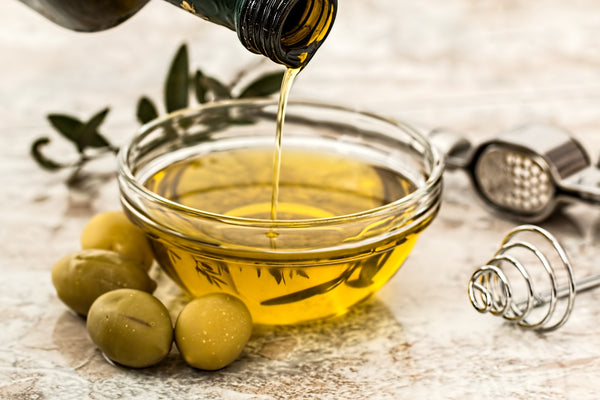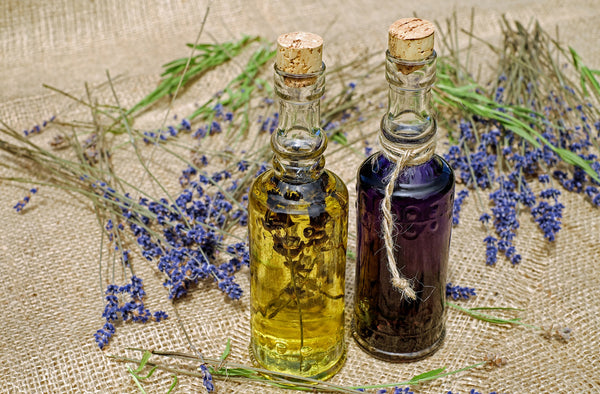Life's hard when you have acne-prone skin. In your teen years, it's often accompanied by oily skin and inflammation. But sometimes even as puberty gives way to young adulthood, the acne and blackheads don't go away. Older adults begin attempting to address wrinkles and acne simultaneously, which can make finding the ideal products for your skin type a big challenge.
Interestingly, even for the oiliest of skin, drying things out often makes the problem worse. In fact, facial oils can sometimes be the solution to oily skin – it's just a matter of finding the right one. The first and most important qualification for choosing an oil is that it’s non-comedogenic. Believe it or not, there's a comedogenic rating system that can help you understand which oils are more or less likely to clog your pores.
Non-comedogenic oils moisturize and nourish without clogging pores (the best ones even help unclog them!) and are an essential ingredient in skincare for all skin types. We highlighted acne-prone skin above because clogged pores are more likely to concern those with acne-prone skin, but no one wants to use skincare products that could create comedones (blackheads and whiteheads).
After understanding the comedogenic scale and the types of fatty acids that are best for each skin type, we'll share the non-comedogenic oils that are easiest to find at your local beauty supply or health foods store.
The Comedogenic Scale

Put simply, the comedogenic scale is a rating system that roughly indicates how likely an oil is to clog pores. While everyone is different, this rating system is a great reference point to help you read your product labels and avoid accidentally causing a problem on your skin. The scores ranges from 0 to 5:
- 0: will not clog pores at all
- 1: very low likelihood of clogging pores
- 2: moderately low likelihood of clogging pores
- 3: moderate likelihood of clogging pores
- 4: fairly high likelihood of clogging pores
- 5: highest likelihood of clogging pores
For our purposes, we'll focus on oils that have a rating of 2 or lower. This scale is based on research from the late 1970s that was initially done on rabbits, and as with almost everything these days, there's a bit of controversy in the skincare community as to how relevant this scale actually is.
That's why, in addition to using the comedogenic scale, we've further honed our list by using fatty acid categories — linoleic and oleic fatty acids — as good indicators of a non-comedogenic oil.
Your individual experience with the oils we list will vary. Our goal is to give you the science and information available to help you choose what's right for you.
Fatty Acid Categories

There are two main fatty acid categories to think about when it comes to skincare: linoleic and oleic acids. While there are a number of other important fatty acids in topical oils, these two types are most relevant when it comes to skincare. Most vegetable and seed oils contain both types, but are categorized by which type they are highest in. These broader categories can also help you determine which oils are best for your skin type.
Generally speaking, oils that have a higher percentage of linoleic acid are lower on the comedogenic scale than those with higher oleic acid. While most products that contain various ingredients won't describe their oily components in these terms, single oil products often do. So it's good to know the two categories of fatty acids as a form of shorthand.
Linoleic Acid
Linoleic acid is the oil most recommended for acne-prone skin. This is because research has shown that acne sufferers have a lower concentration of linoleic acid on their skin's surface, which could be contributing to their clogged pores.
Linoleic acid is an omega–6 fatty acid and is considered an essential fatty acid, which means the body cannot make it on its own. It must be consumed to get those nutrients into the body, but in this case, we're talking about the skin's surface.
There's no evidence that low linoleic acid on the skin's surface is correlated to levels in the whole body, so supplementing orally doesn't seem to make a difference. Linoleic acids have a shorter shelf life, but when combined with high antioxidant essential oils (many of which are also great for addressing acne), they can last on the shelves as carrier oils for much longer.
The most recognizable oils that are high in linoleic acids are:
- Argan oil
- Evening primrose oil
- Grape seed oil
- Safflower oil
- Sunflower oil
- Sesame oil
- Pumpkin seed oil
- Sweet almond oil
- Hemp seed oil
- Sunflower oil
- Walnut oil (also high in omega–3 fatty acids)
Less well-known oils high in linoleic acid are:
- Borage seed oil
- Black currant seed oil
- Cranberry seed oil
- Hazelnut oil
- Manketti nut oil
- Raspberry seed oil
- Rosehip seed oil
Many of these oils are also high in oleic acid, so finding the right balance of the two types of fatty acids for your skin type will help you discover which natural oils are best for you.
Oleic Acid

The best-known oil high in oleic acid is olive oil. Rich in omega–9s (which are non-essential because the body can make them), oleic acids are best known for their hydrating and anti-inflammatory properties, but they can be pore clogging for those with oily, acne-prone, or even combination skin. These effects can be beneficial for acne-prone skin but are more likely to clog pores if your skin tends in that direction. Oleic acid is more ideal for dry skin but can benefit sensitive or irritated skin as well.
While having some percentage of oleic acid is good (or at least not harmful), the non-comedogenic oils have a higher ratio of linoleic to oleic acid. High oleic acid oils have a longer shelf life and are more stable.
High oleic acid oils include:
- Avocado oil
- Shea butter
- Coconut oil
- Olive oil
- Apricot kernel oil
- Jojoba oil
- Moringa oil
- Palm kernel oil
- Sea buckthorn oil
- Tamanu oil
- Neem oil
Some of the oils on this list could be good for treating acne for other reasons even if they are higher in oleic acid. For example, neem, tamanu, and coconut oil are all potent antimicrobials, and we know that acne is at least partially due to an overgrowth of microbes on the skin.
This nuance might mean you should try products that have a high linoleic acid oil base with a touch of one of these antimicrobial oils. For example, you might try using or creating an oil blend with safflower oil as the carrier oil base and a small amount of neem oil to help control bacteria.
Feel offers a daily Squalane Facial Oil Blend, which features rosehip seed oil (high linoleic), squalane (high oleic), grape seed oil (high linoleic), cucumber oil (high linoleic), rice bran oil (about evenly split), and avocado oil (high oleic) for a great mix of oils to both neutralize breakouts, and prevent future clogs and infection.
Non-Comedogenic Oils

Now that we've laid out the list of various high linoleic and oleic acid oils, let's look closer at those that most skincare experts agree are best for acne-prone skin.
Sunflower Seed Oil
Sunflower oil is a gentle oil that many of the sources we consulted suggest starting with first. This is because it has a comedogenic rating of 0, absorbs into the skin quickly, and is incredibly gentle, making it suitable for all skin types. Studies show that sunflower oil can help improve the skin barrier, which is important if your skin is prone to breakouts. If you're new to using oils on your face, this one is a safe bet. Look for cold-pressed, unrefined, organic sunflower oil if you want to avoid GMOs or other harsh extraction chemicals.
Safflower Oil
Safflower oil has a comedogenic rating of 0. It goes on very light, works for all skin types, including sensitive skin, and absorbs into the skin quickly. Its thin consistency makes it a great candidate for oil cleansing, especially for those with oily skin. To find the highest quality oil, look for cold-pressed, unrefined, organic safflower oil.
Grapeseed Oil
Grapeseed oil is not only low on the comedogenic scale — with a rating of 1 — it also helps improve the skin barrier and reduce the appearance of acne scars and hyperpigmentation. All of these qualities make it a stellar facial oil for all skin conditions.
Rosehip Seed Oil
Also with a rating of 1 on the comedogenic scale, rosehip seed oil is a wonderful carrier oil in natural skincare products. Rich in vitamin C, it works well as an anti-inflammatory oil that helps reduce redness, calm rosacea, and reduce the appearance of fine lines and wrinkles. It also has antimicrobial properties, making it a great candidate for acne-prone skin. It's among the best oils for anti-aging and acne simultaneously. Try Feel's AM Essentials Kit for a taste of what a combination of rosehip oil and walnut can do for your skin.
The List Goes On

While there might be some controversy around the comedogenic scale, it remains a good jumping off point — when it’s combined with prioritizing high linoleic acids — to help you find the facial oil that's best for you. The four oils we highlighted are by no means the only non-comedogenic oils out there, but they're some of the easiest to find in skincare, and the sunflower seed oil and safflower oil are some of the least expensive. Give them a try before splurging on the rare and high-priced varieties.






